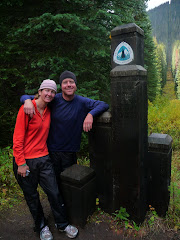 Adrian had this awesome idea to take a small U.S. highway (highway 18) from its start, in Wisconsin, to its end, in Wyoming.
Adrian had this awesome idea to take a small U.S. highway (highway 18) from its start, in Wisconsin, to its end, in Wyoming.You have to admit it is sort of romantic. And no, I'm not being sarcastic. Hitting a road that is not a giant 8-lane freeway is appealing albeit slower. So that's what we did.
 Our first night we stayed in a motel in a tiny town smack dab in the middle of South Dakota's bottom half. When Adrian asked about restaurants, the manager/owner pointed out the two gas stations that prepare "some damn good rotisserie chicken and pizza" and then invited us to join their pool game in a garage off the main building. We picked pizza. It was damn good. Adrian added in a pickle for good measure. I'm not sure what the additional pickle accomplished, but Adrian enjoyed it.
Our first night we stayed in a motel in a tiny town smack dab in the middle of South Dakota's bottom half. When Adrian asked about restaurants, the manager/owner pointed out the two gas stations that prepare "some damn good rotisserie chicken and pizza" and then invited us to join their pool game in a garage off the main building. We picked pizza. It was damn good. Adrian added in a pickle for good measure. I'm not sure what the additional pickle accomplished, but Adrian enjoyed it. The following morning, we questioned our decision to take smaller roads as Adrian plowed his way through drifting snow. We moved south into Nebraska and took the equally petite highway 20 the rest of the way into Wyoming. We hooked back up with highway 18 until interstate 25 for its official finish and by then the snow was gone.
The following morning, we questioned our decision to take smaller roads as Adrian plowed his way through drifting snow. We moved south into Nebraska and took the equally petite highway 20 the rest of the way into Wyoming. We hooked back up with highway 18 until interstate 25 for its official finish and by then the snow was gone. That night we settled in with our friends in Denver and enjoyed a meal sans bagged pickle.

 talking big. Some of it's fantastic - our parks, our confidence, our generosity, diversity, willingness to take risks, our ability to bounce back from failure and to persevere.
talking big. Some of it's fantastic - our parks, our confidence, our generosity, diversity, willingness to take risks, our ability to bounce back from failure and to persevere.














 El Bolson, is probably best known for its crafts market that feature preserves made from the hordes of blackberry and raspberry bushes in the area as well as leather, wool goods and handmade jewelry.
El Bolson, is probably best known for its crafts market that feature preserves made from the hordes of blackberry and raspberry bushes in the area as well as leather, wool goods and handmade jewelry.

 But .... I have to wonder what the city's powers-that-be said upon receiving it. Um, gee thanks.
But .... I have to wonder what the city's powers-that-be said upon receiving it. Um, gee thanks.
 Before and after our five-day trek to Nahuel Huapi, we stayed in San Carlos de Bariloche, located in the western side of the Rio Negro province. The town is smack dab in the middle of Nahuel Huapi National Park and it's main civic center is just up the hill from the Nahuel Huapi Lake.
Before and after our five-day trek to Nahuel Huapi, we stayed in San Carlos de Bariloche, located in the western side of the Rio Negro province. The town is smack dab in the middle of Nahuel Huapi National Park and it's main civic center is just up the hill from the Nahuel Huapi Lake.
 Bariloche also is known for its chocolate and dozens of chocolatiers line the main street. We sampled our fair share of the chocolate treats and brought along a small stash of them for our trek.
Bariloche also is known for its chocolate and dozens of chocolatiers line the main street. We sampled our fair share of the chocolate treats and brought along a small stash of them for our trek.



